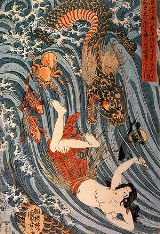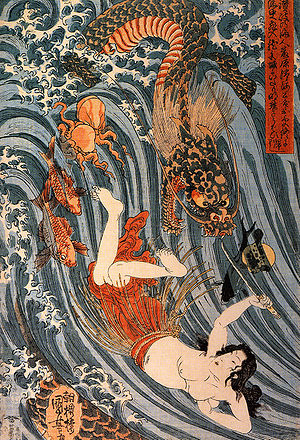
Ryujin
Encyclopedia

Watatsumi
was a legendary Japanese dragon and tutelary water deity. In Japanese mythology, is another name for the sea deity Ryūjin 龍神; and the ruling the upper, middle, and lower seas were created through the divine progenitor Izanagi's ceremonial purifications after returning from Yomi "the...
, was the tutelary deity of the sea
Sea
A sea generally refers to a large body of salt water, but the term is used in other contexts as well. Most commonly, it means a large expanse of saline water connected with an ocean, and is commonly used as a synonym for ocean...
in Japanese mythology
Japanese mythology
Japanese mythology is a system of beliefs that embraces Shinto and Buddhist traditions as well as agriculturally based folk religion. The Shinto pantheon comprises innumerable kami...
. This Japanese dragon
Japanese dragon
Japanese dragons are diverse legendary creatures in Japanese mythology and folklore. Japanese dragon myths amalgamate native legends with imported stories about dragons from China, Korea and India. The style of the dragon was heavily influenced by the Chinese dragon...
symbolized the power of the ocean
Ocean
An ocean is a major body of saline water, and a principal component of the hydrosphere. Approximately 71% of the Earth's surface is covered by ocean, a continuous body of water that is customarily divided into several principal oceans and smaller seas.More than half of this area is over 3,000...
, had a large mouth, and was able to transform into a human
Human
Humans are the only living species in the Homo genus...
shape. Ryūjin lived in Ryūgū-jō
Ryugu-jo
In Japanese mythology, Ryūgū-jō is the undersea palace of Ryūjin, the dragon god of the sea. Depending on the version of the legend, it is built from red and white coral, or from solid crystal. The inhabitants of the palace were Ryūjin's servants, which were various denizens of the sea...
, his palace under the sea built out of red and white coral
Coral
Corals are marine animals in class Anthozoa of phylum Cnidaria typically living in compact colonies of many identical individual "polyps". The group includes the important reef builders that inhabit tropical oceans and secrete calcium carbonate to form a hard skeleton.A coral "head" is a colony of...
, from where he controlled the tide
Tide
Tides are the rise and fall of sea levels caused by the combined effects of the gravitational forces exerted by the moon and the sun and the rotation of the Earth....
s with magical tide jewels
Tide jewels
In Japanese mythology, the and -- were magical gems that the Sea God used to control the tides. Classical Japanese history texts record an ancient myth that the ocean kami Watatsumi 海神 "sea god" or Ryūjin 龍神 "dragon god" presented the kanju and manju to his demigod son-in-law Hoori, and a later...
. Sea turtle
Sea turtle
Sea turtles are marine reptiles that inhabit all of the world's oceans except the Arctic.-Distribution:...
s, fish
Fish
Fish are a paraphyletic group of organisms that consist of all gill-bearing aquatic vertebrate animals that lack limbs with digits. Included in this definition are the living hagfish, lampreys, and cartilaginous and bony fish, as well as various extinct related groups...
and jellyfish
Jellyfish
Jellyfish are free-swimming members of the phylum Cnidaria. Medusa is another word for jellyfish, and refers to any free-swimming jellyfish stages in the phylum Cnidaria...
are often depicted as Ryūjin's servants.
Ryūjin was the father of the beautiful goddess
Goddess
A goddess is a female deity. In some cultures goddesses are associated with Earth, motherhood, love, and the household. In other cultures, goddesses also rule over war, death, and destruction as well as healing....
Otohime who married the hunter prince Hoori
Hoori
, also known as Hikohohodemi no Mikoto, was, in Japanese mythology, the third and youngest son of the kami Ninigi-no-Mikoto and the blossom princess Konohanasakuya-hime. He is one of the ancestors of the Emperors of Japan. He is also called Hohodemi and is most frequently known as Yamasachihiko ,...
. The first Emperor of Japan
Emperor of Japan
The Emperor of Japan is, according to the 1947 Constitution of Japan, "the symbol of the state and of the unity of the people." He is a ceremonial figurehead under a form of constitutional monarchy and is head of the Japanese Imperial Family with functions as head of state. He is also the highest...
, Emperor Jimmu
Emperor Jimmu
was the first Emperor of Japan, according to the traditional order of succession. He is also known as Kamuyamato Iwarebiko and personally as Wakamikenu no Mikoto or Sano no Mikoto....
, is said to have been a grandson of Otohime and Hoori's. Thus, Ryūjin is said to be one of the ancestors of the Japanese imperial dynasty.
Alternative legends
According to legendLegend
A legend is a narrative of human actions that are perceived both by teller and listeners to take place within human history and to possess certain qualities that give the tale verisimilitude...
, the Empress Jingū
Jingu of Japan
, also known as , was a legendary Japanese empress. The empress or consort to Emperor Chūai, she also served as Regent from the time of her husband's death in 209 until her son Emperor Ōjin acceded to the throne in 269...
was able to carry out her attack into Korea
Korea
Korea ) is an East Asian geographic region that is currently divided into two separate sovereign states — North Korea and South Korea. Located on the Korean Peninsula, Korea is bordered by the People's Republic of China to the northwest, Russia to the northeast, and is separated from Japan to the...
with the help of Ryūjin's tide jewels. Upon confronting the Korean navy
Navy
A navy is the branch of a nation's armed forces principally designated for naval and amphibious warfare; namely, lake- or ocean-borne combat operations and related functions...
, Jingū threw the into the sea, and the tide receded. The Korean fleet was stranded, and the men got out of their ships. Jingū then threw down the and the water rose, drowning the Korean soldiers. An annual festival, called Gion Matsuri
Gion Matsuri
The takes place annually in Kyoto and is one of the most famous festivals in Japan. It spans the entire month of July and is crowned by a parade, the on July 17. It takes its name from Kyoto's Gion district....
, at Yasaka Shrine
Yasaka Shrine
', once called , is a Shinto shrine in the Gion District of Kyoto, Japan. Situated at the east end of Shijō-dōri , the shrine includes several buildings, including gates, a main hall and a stage.-History:...
celebrates this legend.
Another legend involving Ryūjin is the story about how the jellyfish
Jellyfish
Jellyfish are free-swimming members of the phylum Cnidaria. Medusa is another word for jellyfish, and refers to any free-swimming jellyfish stages in the phylum Cnidaria...
lost its bone
Bone
Bones are rigid organs that constitute part of the endoskeleton of vertebrates. They support, and protect the various organs of the body, produce red and white blood cells and store minerals. Bone tissue is a type of dense connective tissue...
s. According to this story, Ryūjin wanted to eat monkey
Monkey
A monkey is a primate, either an Old World monkey or a New World monkey. There are about 260 known living species of monkey. Many are arboreal, although there are species that live primarily on the ground, such as baboons. Monkeys are generally considered to be intelligent. Unlike apes, monkeys...
's liver
Liver
The liver is a vital organ present in vertebrates and some other animals. It has a wide range of functions, including detoxification, protein synthesis, and production of biochemicals necessary for digestion...
(in some versions of the story, to heal an incurable rash
Rash
A rash is a change of the skin which affects its color, appearance or texture. A rash may be localized in one part of the body, or affect all the skin. Rashes may cause the skin to change color, itch, become warm, bumpy, chapped, dry, cracked or blistered, swell and may be painful. The causes, and...
), and sent the jellyfish to get him a monkey. The monkey managed to sneak away from the jellyfish by telling him that he had put his liver in a jar in the forest and offered to go and get it. As the jellyfish came back and told Ryūjin what had happened, Ryūjin became so angry that he beat the jellyfish until its bones were crushed.
In Shinto
is a form of Shinto religious belief that worships dragons as water kamiKami
is the Japanese word for the spirits, natural forces, or essence in the Shinto faith. Although the word is sometimes translated as "god" or "deity", some Shinto scholars argue that such a translation can cause a misunderstanding of the term...
. It is connected with agricultural rituals, rain prayers, and the success of fishermen.
In popular culture
Genryusai Shigenkuni Yamamoto from the anime Bleach uses a blade calle Ryuijin Jakka(Flowing Flame Blade, according to the Viz translation)External links
- Ryūjin shinkō, Encyclopedia of Shinto

